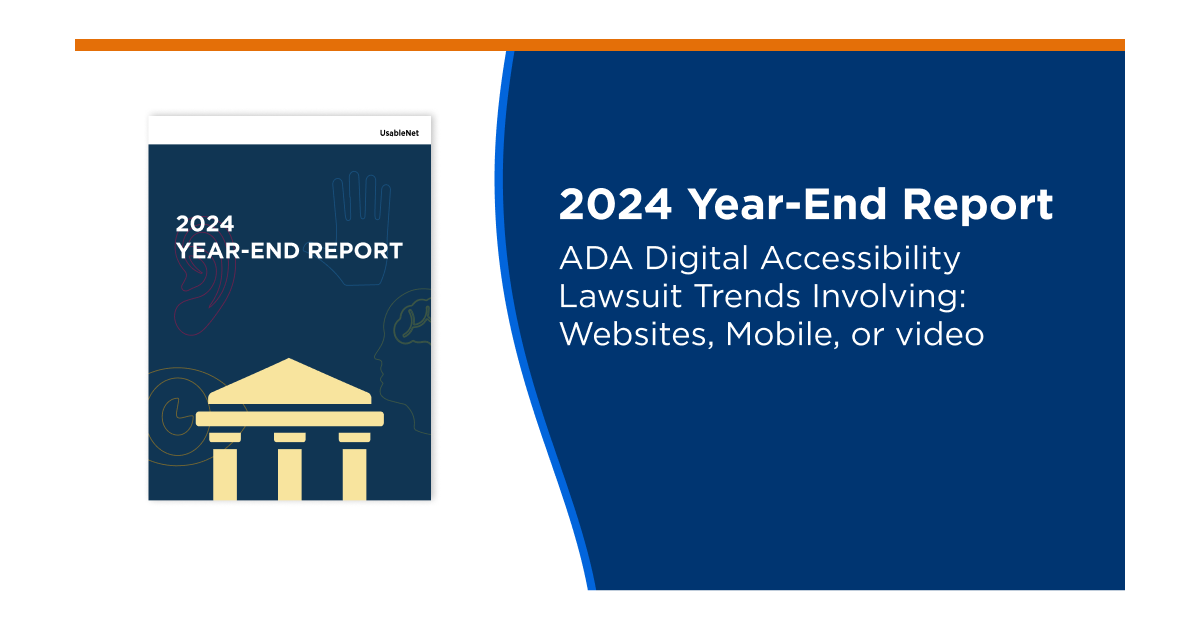In 2024, digital accessibility lawsuits pose a growing legal risk, particularly for consumer goods and services businesses. With increasing attention to web accessibility compliance and shifting legal trends, legal departments must stay informed and proactively protect their organizations.
*While ADA lawsuits are a significant concern in the U.S., companies serving customers in the EU via their websites will soon face additional requirements under the European Accessibility Act (EAA). Compliance with the EAA will be crucial to avoiding legal risks in Europe.
Sign up for our webinar, Navigating the European Accessibility Act (EAA): Requirements and Best Practices to learn more about these new regulations and how to ensure your company meets accessibility standards.
Below, we explore critical insights into the current landscape of digital accessibility lawsuits and strategies for mitigating these risks.
The Rise of State-Level Lawsuits
A significant trend in 2024 is increased digital accessibility lawsuits filed at the state level. Currently, plaintiffs file 56% of cases in federal courts, with 44% filed at the state level. This shift from federal to state courts is primarily due to federal judges becoming less tolerant of "serial plaintiffs"—those filing numerous similar lawsuits. As a result, many plaintiff firms are shifting their cases to state courts, particularly in states like New York and California, where laws favor plaintiffs.
This trend highlights the need for legal departments to comply with federal and state regulations. Companies must diligently address accessibility across their digital properties to avoid legal exposure in multiple jurisdictions.
E-Commerce Websites: Prime Targets
E-commerce companies, especially those within the consumer goods and services industry, are often the targets of accessibility lawsuits. The complexity of e-commerce websites, including product catalogs, shopping carts, and third-party payment systems, makes them prone to accessibility barriers. If a user with a disability encounters difficulty completing a purchase, the company could face a lawsuit.
More prominent brands are particularly vulnerable, as their visibility and more comprehensive digital presence make them easier targets. Ensuring WCAG compliance for all digital platforms is crucial for legal departments to protect their organizations from these lawsuits.
Recent Lawsuit Trends: Insights from September
To better understand the ongoing legal risks, it's helpful to look at the data from September 2024, a typical month for digital accessibility lawsuits. During September, 281 lawsuits were filed, with New York and Florida leading the way in the number of cases. As expected, the lawsuits primarily targeted e-commerce companies, but they also extended into sectors such as hospitality and financial services.
At UsableNet, we track ADA website compliance lawsuits every month, and the data consistently shows that these numbers remain high throughout the year. We encourage you to bookmark our ADA Website Compliance Lawsuit Tracker and check back regularly to stay updated on trends and see where lawsuits occur most frequently.
Understanding the current landscape can help businesses assess their risk and take timely action to improve accessibility.
The Cost of Settling Accessibility Lawsuits: More Than Just a One-Time Expense
One of the critical points for legal teams to understand is that settling a digital accessibility lawsuit is not a one-time fix. The average cost of settling a lawsuit ranges from $10,000 to $30,000, depending on the case's complexity. However, settling with one plaintiff does not shield the company from future lawsuits. Costs can escalate if multiple plaintiffs bring similar claims, and paying one settlement does not make the company immune to future legal challenges. Companies that fail to address the root causes of accessibility issues can be sued multiple times, leading to substantial financial and reputational risks.
The Dangers of Accessibility Widgets
Many companies turn to accessibility widgets as a quick fix for compliance. Still, these tools often need improvement to achieve full WCAG compliance. Widgets that offer features like text resizing or color contrast adjustments can sometimes create additional barriers, particularly for screen reader users, who are often the plaintiffs in these lawsuits.
Relying solely on widgets can make companies more vulnerable to lawsuits. Legal teams must recognize that widgets do not address fundamental accessibility issues, and using them as the primary solution could put the company at greater legal risk. A more comprehensive, sustainable approach to digital accessibility is necessary to ensure long-term compliance and reduce lawsuit exposure.
Proactive Strategies to Reduce Legal Risks
To minimize the risk of accessibility lawsuits, legal departments must adopt a proactive approach to ensure ongoing compliance with WCAG standards. Key steps include:
- Regular Accessibility Audits: Conduct thorough audits of your website and digital platforms, ideally with third-party experts, to assess compliance with the latest WCAG standards.
- Comprehensive Testing: Perform manual, automated, and user testing with individuals who have disabilities to identify and resolve accessibility barriers.
- Vendor and Third-Party Compliance: Ensure that third-party services, such as payment systems or content management platforms, are accessible. A failure in these components can create legal liability for your company.
- Contractual Protections: To mitigate risks related to third-party components, incorporate accessibility compliance requirements into contracts with vendors and service providers.
By following these steps, legal teams can significantly reduce their lawsuit exposure and demonstrate their company's commitment to digital accessibility.
Final Thoughts
In 2024, digital accessibility lawsuits are rising, with state-level filings becoming more common and e-commerce platforms frequently targeted. While settling a lawsuit may seem easy, it does not eliminate the risk of future lawsuits. Companies that fail to resolve underlying accessibility issues will remain vulnerable to repeated legal challenges. Additionally, relying on accessibility widgets can increase the likelihood of lawsuits rather than mitigate them.
To protect against these risks, legal departments must adopt a proactive, comprehensive approach to digital accessibility. Ensuring compliance with WCAG standards and addressing accessibility barriers will help reduce the risk of lawsuits and enhance the user experience for all customers.
For more insights into digital accessibility lawsuits in 2024, watch UsableNet's webinar featuring legal expert Joseph Piesco and Chief Innovation Strategist Jason Taylor. Watch Now: Webinar on Web Accessibility Lawsuits in 2024!








